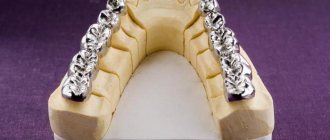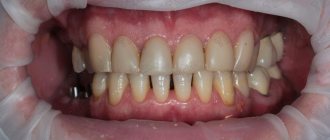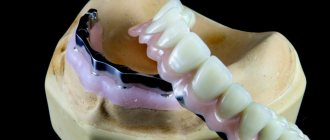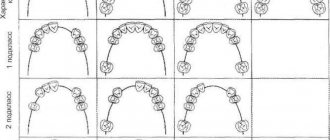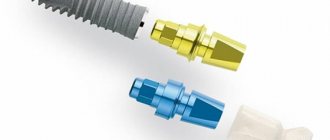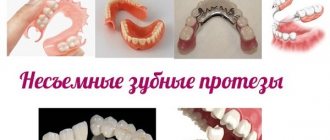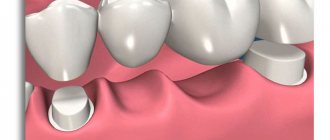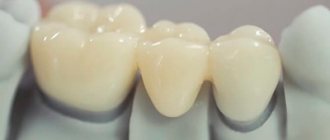A beautiful smile is the dream of every person, and it’s good when it’s natural, but this is becoming less and less common. Under the influence of many negative factors, such as the environment, nutrition, hygiene, injuries, the problem of missing several teeth occurs in many people. Removable dentures come to the rescue. They are attached to existing teeth with clasps. What kind of devices are these, what types are there and what harm can they cause?
Concept and structure of clasps
Clasps are special clamps with which a removable denture is attached to the teeth. In addition, these clamps distribute the chewing load evenly over the entire surface of the jaw.
They consist of the following elements:
- Shoulder. The part that covers the tooth, in turn, is divided into supporting (maintains rigidity and prevents lateral movement) and retaining (provides fixation of the prosthesis).
- Body. The spring base of the clamp, connecting all its fragments and located on the contact surface of the crown.
- Process. Designed for attaching the lock to the prosthesis frame.
The support-retaining fixture also contains an occlusal pad, which allows you to hold the tooth without displacement under the action of angular force. There is also an anchor part with which the clamp is connected to the metal frame.
READ ALSO: how and why are dental veneers used?
Side effects from clasps
The main side effects of clamps include:
- abrasion of enamel in places of friction or due to improper installation;
- the development of caries and other dental problems due to a decrease in the level of hygiene, accumulation of plaque under the wire and elements of the prosthesis;
- loosening of supporting elements due to movements of the orthodontic structure and constant overload of the supports.
Denture clasps can cause:
- To the abrasion of the tooth enamel itself due to constant load and micro-movements.
- This leads to a significant deterioration in the hygienic condition of the mouth due to the fact that the clasp is a separate structure and various food debris can accumulate under it. As a result, carious processes begin to develop very quickly. And this destroys the supporting teeth.
- Clasps can cause teeth to become very loose. This happens due to the movements of the prosthesis in a horizontal position. As a result, there is a functional overload of the teeth, which serve as support.
Classification: types and features of clasps
Fixators are different depending on the prosthesis, material, and functions performed. The most popular clamps include:
- Bonneville. It consists of two onlays that are fixed in the fissures of molars and premolars. They are used for unilateral missing teeth.
- Jackson. Reversible design, which is a loop. Can be cast or wire.
- Dentoalveolar. Made of plastic, reinforcement possible. It is used when it is necessary to achieve an aesthetic effect.
- Round one-shoulder. They are usually folded onto the molars.
- Schwartz. It bends out of the orthodontic wire and occupies the interdental space. It can be single-link or multi-link.
- Adams. A button lock, consisting of two fixing protrusions, curved towards each other, and two bodies, on the inside turning into processes.
- Duisings. It is bent like a Jackson clasp, but has two semicircular bends at the shoulder, two bodies and two appendages.
- Reichelman. It differs from others in the shape of the lining, which looks like a transverse bar, which goes through the chewing surface into the inside of the oral cavity.
Modern classification
All clasps are divided according to the type of material from which they are made:
- Metal. It can be gold, gold-platinum alloy, stainless steel.
- Plastic. This type of material is used less frequently. Its use is justified only in aesthetically significant areas.
- Combined options made of metal and plastic.
In addition to separation by material, various designs are distinguished depending on the method of their preparation:
- bent, which are made by bending wire;
- cast, which are cast during the manufacturing process of the prosthesis.
By function they distinguish:
- holding;
- supporting and retaining.
Separation according to the principle of connection with the prosthesis:
- hard;
- springy;
- labile.
Options for fitting the bracket:
- dentogingival;
- gingival;
- dental
There is also a division according to the type of coverage of the tooth surface with fasteners:
- one-armed and two-armed;
- reversible;
- multi-link;
- annular;
- T-shaped;
- double.
T-clasp
Now the most widely used:
- one-shouldered;
- extended;
- dentoalveolar;
- gingival.
How should the clasps be positioned?
Depending on the desired result, the clamps are located:
- below the equator of the tooth (used more often on retaining dentures),
- above the equator line (in support-holding),
- on the occlusal surface (used in supporting orthodontic structures).
Clasp clamps are positioned for a good fixing effect, taking into account the following factors:
- the object for installation of the fixator must be healthy and motionless, have the correct anatomical shape,
- fixatives should not injure the mucous membrane,
- refurbishment must be carried out
- With multi-link retainers, there must be sufficient space between the teeth.
Boundary line
The location of the boundary line is of great importance when choosing the type of clasps to be installed.
There are 5 options for its placement:
- The boundary line originates from the contact point of the row element on the side where the pathology is located and descends to the center of the proximal region of the adjacent tooth. In this case, the use of clasps with long holding arms is effective.
- The equator line is located in the center of the approximal surface and is directed towards the contact point of the adjacent tooth along the lingual or buccal side. The situation requires the use of support and retention mechanisms.
- The boundary line is placed diagonally on the surface of the supporting element - from the chewing area in the defect area to the neck of the element on the reverse side. Experts prefer to use Ney clasps for this pathology.
- The boundary line is located low, the equator passes in the area of the tooth neck . To fix the prosthetic structure, the use of support clasps is required.
- A high location of the equator occurs in cases of increased tooth abrasion. To restore their functionality and appearance, artificial crowns are required.
Manufacturing: technology and materials
In orthodontics, clasp retainers are bent with forceps to obtain the required shape. Requirements for making a retainer:
- the shoulder should cover the cervical or vestibular part of the tooth,
- the shoulders should not pull or put pressure on the support unit,
- the clamp must touch the entire surface, otherwise the enamel will be erased at the point of contact,
- after production, polishing is required so as not to injure the mucous membrane,
- the shoulders should be elastic.
Depending on the material of manufacture, clasp clamps are:
- metal (more aesthetic, but less reliable),
- plastic (inferior to metal ones in reliability),
- combined.
In the production of nylon prostheses, it is possible to use clasps made of the same material. Such retainers are located near the gums, are practically invisible and do not damage the enamel.
Classification of denture attachments
In most cases, reviews of Quadrotti designs are positive and adaptation to them is much faster than in other cases.
Advantages:
- high aesthetics;
- reliable fixation and quick adaptation;
- hypoallergenic material;
- the thin frame of the prosthesis does not interfere with the tongue and does not spoil diction;
- durability (use period from 5 to 10 years);
- even with prolonged use, the prosthetic material does not lose its original color and structure;
- During manufacturing, it is possible to scent the cast structure, which makes the prosthesis pleasant to use.
Flaws:
- quite high price for material and manufacturing;
- the design requires special care and, accordingly, the purchase of related products;
- not designed for heavy loads (it’s better not to bite nuts);
- The prosthesis cannot be repaired; if it breaks, a new one will have to be made.
There are several types of classification of clamps:
- by material: metal, high-quality plastic, combined;
- in shape: round, semicircular, ribbon;
- by fit: gingival, dental, combined;
- by function: holding, support-holding;
- in connection with the prosthesis: rigid, articular, springy;
- according to the degree of coverage of the dental unit: 1, 2 arms, multi-link, double, T-shaped, ring-shaped.
The hygiene of a nylon denture differs little from usual dental procedures. The denture needs to be rinsed with running water after each meal. Brush it twice a day with low-abrasive toothpaste.
Once a day, the prosthesis is disinfected in a special solution for several hours. Experts recommend placing the prosthesis in a container protected from sunlight. About once every six months it is worth contacting a specialist to clean the prosthesis of hard deposits.
A nylon prosthesis quickly loses its original attractiveness when overused with brightly colored foods and drinks. After drinking coffee or tea, your denture will need to be cleaned as soon as possible.
Acrylic dentures with clasps are based on a rigid frame made of thin wire. It passes under all artificial teeth and forms a strong base. This gives a certain reliability, preventing the acrylic from deforming when bitten. Small hooks from the inside cover the supporting units, which are usually incisors or “fours”.
Advantages and disadvantages
Such dentures are attached to hooks in several places, so they can be installed on the upper or lower jaw. Among the positive aspects of prosthetics using this method:
- low price with good quality;
- simple manufacturing and repair process;
- Possibility of use as a temporary replacement for 1–2 teeth.
It should be remembered that acrylic is essentially plastic, so there are certain disadvantages of such a hooked prosthesis:
- noticeable when located in the smile zone;
- the massive base creates inconvenience;
- There may be disturbances in the pronunciation of sounds;
- taste sensations worsen.
Due to its fragility, acrylic prosthesis is rarely used in the manufacture of structures that imitate the jaw. The average wearing period does not exceed 4–5 years.
Installation Features
The clamps are installed on healthy, sanitized teeth of the correct shape. Do not install prostheses with retainers if:
- deep bite,
- the presence of inflammatory processes in the oral cavity,
- absence of supporting teeth or their inconsistency,
- atrophy of the bone tissue of the jaw and teeth,
- allergies to structural components,
- diabetes mellitus,
- acute forms of cardiovascular diseases,
- oncological diseases.
Location requirements
When placing clasps, abutment teeth must meet the following requirements:
- Be resilient. If there is pathological mobility, it must be eliminated before fixation of the prosthetic structure begins. Inflammatory processes occurring in the body of the tooth should be treated to avoid further spread and destruction of the elements of the row.
- Have the correct form. Contraindications to the placement of clasps are short tooth height, exposure of the neck, and incorrect ratio of the length of the row element and its root system.
- Correctly relate to antagonist teeth. This will help avoid increasing the height of the bite by choosing a more suitable row element or installing a protective crown.
For what purpose is polishing a removable denture performed and with what tools?
In this publication we will look at the features of the Valplast nylon prosthesis.
Clasps holding and supporting holding, bent and cast, Ney and Adams
Clasps in dentistry are used for two purposes - to hold the rubber dam (during dental treatment) and to fix removable dentures. Here we will talk about the second.
Clasps are designed to strengthen the removable denture on the jaw and prevent the denture from becoming literally removable. At the most inopportune moment. They can also transfer the load when chewing food to the teeth (only supporting clasps).
Classification of clasps into support and support-holding
supporting
- only hold the prosthesis on the jaw. Transferring the entire chewing load to the gums.
support-holding
- not only prevent the prosthesis from falling, but also load the teeth on which they are supported. They transfer approximately 80% of the load to the supporting teeth and only the rest to the gums.
Which clasp option should I use? The orthopedic dentist will decide during the consultation. Based on the number of remaining teeth and their stability in the bone:
Example:
If there are up to 4 teeth left on the jaw and their condition is far from ideal, then the supporting clasps will clearly overload them. And in a few years there will be an inevitable separation from them. Supporting ones will prevent teeth from leaving prematurely. Since they will not overload them.
Types of clasps by materials and manufacture
The most durable material suitable for making clasps is metal. They will ensure the maximum service life of the entire prosthesis.
In this case, they can be bent from a special wire or cast individually from metal:
Bent clasps
Simple and reliable as a Kalashnikov assault rifle. They can withstand the process of putting on and taking off dentures for a very long time. In which they have to constantly bend. They are round and factory made. The technology of rolling the wire itself provides them with very good springy properties. They can be easily bent, changing the degree of retention of the dentures. If they work correctly, they can be made almost invisible. Like in this case:
Minuses
The lifespan of the clasp will depend on the area where it is attached to the base of the prosthesis. But in case of possible breakdown, it is easily repaired.
If the teeth are highly inclined, it is impossible to use them without treating the teeth - then you will have to make individually cast clasps.
Cast clasps
Manufactured and cast individually. There are many varieties of cast clasps. The generally accepted classification of Ney clasps is from type 1 to type 5. Some are named after their creators: type 1 - Acker, double - Bonneville, type 2 - Roach.
Overview of modifications
Clasps have different functional features and are used in accordance with the individual structural characteristics of the patient’s jaw arches and the current clinical situation.
Support-holding
Support-retaining structures were an improved model of a simple wire hook, fixed directly in the neck area of the support unit.
Through technological developments, support structures have been modernized:
- two types of retaining clasp were designed: alveolar and dentoalveolar;
- The classic system of support-retaining structure is represented by its components: two arms, a process and an occlusal pad.
Ney system
The system can be classified as a standard version of a support-retaining clasp, and the materials are highly wear-resistant during operation. Design features of the Ney system:
- the thickened body and the upper shoulder area are modeled with a sufficient level of rigidity to eliminate frequent fractures directly in the area of articulation with the base;
- the upper part is positioned above a given centerline: this position provides stable support for the frame and creates an obstacle to lateral displacement;
- the lower part is specially thinned and placed below the boundary line, its functionality lies in reliable fixation of the prosthesis, preventing displacement;
- has a wedge-shaped shape: the hard thickened shoulder becomes thinner towards the bottom.
The system is universal, because when fixing there is no need to use a crown for any condition of natural teeth.
The Ney system is designed in such a way that the load on the jaw mechanism is distributed as evenly as possible, without damaging the enamel.
Roach clasps
The use of this type is not possible in all clinical situations, but they are a universal option for anatomically short crowns.
Design Features:
- the design consists of a long rod body and long arms; due to this structure, the element becomes elastic and springs well, which reduces the horizontal load on the teeth;
- rod elements can be used on both sides;
- ensures a highly aesthetic smile.
The Roach model, with all its apparent advantages, cannot be used in case of anatomical violation of the dentition. This also applies to high upper gums that open when smiling.
Acker clasps
This type of model is considered the most effective in its functionality. Acker design features:
- the rigid and durable composition of the system allows it to be fixed to molars;
- the use of the design is justified in the absence of one or two teeth in a row, provided that the supporting units are intact;
- a rigid frame blocks the displacement of clasp dentures;
- practical accessibility.
However, the rigidity and strength of a structure is not always the only guarantee of stability. When using Acker clasps, low elasticity is noted, which limits the possibilities of their use.
Bonneville
The Bonville design guarantees high fixation and stabilization of the prosthesis in the oral cavity, but only if there is sufficient space between the antagonists.
Item Features:
- the design has four arms that perform a holding function, while two of them can also perform a stabilizing function;
- equipped with two occlusal pads, fixed on premolars and molars, prevents food from entering during the act of chewing.
Clasps of this type are used to fix corrective devices for small unilateral anomalies, as well as to preserve elements of the jaw arch on the opposite side.
Jackson
This model belongs to the support-retaining systems of the flip-over type and is visually visible as a kind of loop. Peculiarities:
- placed in the interdental space, encircling the supporting unit, and located below the equator on the vestibular surface;
- support is provided by those parts of the loop that lie in the interdental zone;
- elements responsible for fixation are located below the equator;
- This type of model is available in three options: wire, elastic, and cast.
The Jackson model does not injure the enamel and ensures high stability of the prosthesis in the oral cavity.
Let's find out why the denture rubs and what to do in such a situation.
In this publication you will find useful information about the T Crystal removable denture.
Here https://www.vash-dentist.ru/protezirovanie/semnyie-p/zubnyie-na-prisoskah.html all the most important things about dentures with suction cups
Manufacturing Basics
Clasps are made by technologists who focus on the prosthesis that will be installed on the patient. The manufacturing technology goes through the following sequence of actions:
- the clasp is essentially a hook that secures the prosthesis, so it is given the desired shape using specialized forceps, round nose pliers or pliers;
- first, a shoulder is formed that covers the dental crown;
- then the body itself is formed.
Dental technicians make the necessary bends to form clasps quickly and accurately, in just a few bends.
Features of the production of the shoulder and contact process
The desired shape of the clasp is formed using round nose pliers. The contact process and the shoulder are formed as separate elements using different tools.
The contact process is first formed with pliers and then flattened on an anvil. This procedure is necessary to apply special notches that promote tight bonding of the process to the base.
A number of rules apply to the manufacture of a shoulder:
- the shoulder must have a sufficient level of elasticity, which is more typical of wire elements than cast ones;
- the shoulder is designed in such a way that its parts lie between the gum and the equator;
- when fixed to an abutment tooth, the material should not cause discomfort;
- the element must adhere to the tooth surface at all points of contact in order to prevent excessive pressure and thinning of the enamel;
- After rounding the shoulder, it must be thoroughly polished to avoid possible trauma to the mucous systems.
The video shows the manufacturing process of Jackson clasps.
